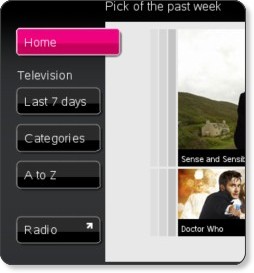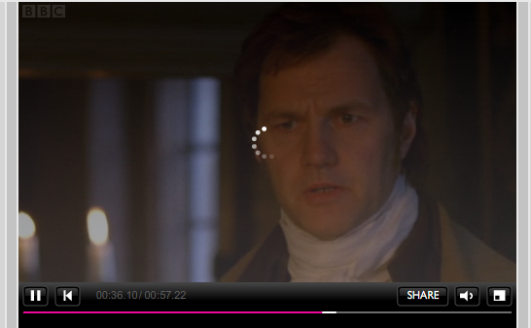Watching TV online is becoming a bit of a hobby of mine. I don’t have a TV anywhere in the house, and it is just so much more convenient to be able to watch what I want, when I do, without having to play around with channels or digital interfaces which seem built to be slow (i.e. digital TV). Early efforts to watch online were riddled with frustration. I trialed Joost along with however many millions of others who signed up for a Beta invite, but found the system clunky and without real appeal in the frankly poor content. Also, it was a memory hog and froze my then-ageing Dell. There was also the problem with pirates and ‘linked TV’ Not only is there the conscience to console, but one popular link site, tv-links.co.uk, actually landed its founder in prison. YouTube only provides short clips, or pirated episodes which are quickly removed by moderators.
So, where does that leave the casual TV-watcher? With all the early difficulty of installing software, finding Betas, or perusing content which either didn’t work or you didn’t want to play, it seemed that watching tv-quality content online has always been a struggle. With new improvements, though, can you actually watch TV online easily and relatively free from frustration? I think it’s getting there.
UK TV Online
First, I’d like to note that I will be avoiding Hulu and any discussion of it aside from mentioning that it doesn’t work in the UK. Both of the services reviewed below, to be fair to US readers, currently only work in the UK.
BBC: iPlayer
The British Broadcasting Corporation produces high-quality tv and radio content, and, because if its unique funding contains no advertisements. The aim of the iPlayer is to provide access to all BBC content for up to seven days following broadcast. The player itself is Flash-based and inside the browser, with full-screen capability.
The menu system is intuitive and simple. You can navigate by channel (there are several BBC channels, including dedicated children’s and world news stations), category, show title or by broadcast day–up to seven previous. The Flash interface allows a quick summary view of each show, with a still image or a show logo. Clicking on any icon will bring up a summary and a playing screen which waits for you to choose to start.
One slightly annoying feature is a lack of ‘Back’ function. If you choose a show you decide not to watch, you either have to go back using the browser (slightly risky with Flash) or re-navigate using one of the categorisation options. The image and sound quality of the content is excellent, though, and the overall feel of the interface is brilliant.
Viewers have the option of streaming content or downloading it for later watching (though the DRM allows it to show for only up to the 7-day deadline). The download feature works exclusively with Internet Explorer, though Firefox or Opera work fine for streaming. Each episode also seems to have a permalink system, so, provided you are within the 7-day restriction, you can share content using links.
My initial impressions of the iPlayer are all positive. The content is not compromised: it shows all BBC materiel. The 7-day limit seems fair for free content, and the player works very well indeed. The quality of the interface and of the actual content is uncompromising, and you can actually sit down, choose a programme, and watch it.
Well, mostly…

Although most of the time it works that way, if you are on restricted bandwidth, you are out of luck. All that quality really costs to deliver in terms of download speeds. I am fortunate to now live in a relatively uninhabited corner of these crowded Isles, so I can watch the iPlayer at more or less any time. At my previous house in the South-East, however, my ISP could only provide me with a 1MG connection or less during high-traffic times. Even now, however, I can experience that horrible Flash loading circle, and it tends to continue circling once its’ started.
This aspect of the iPlayer has caused something of a national stir. It has been reported that ISP’s are demanding the BBC actually cover the cost of more people using more bandwidth due to watching content online. I can’t say I see the ISP’s logic in this one. After all, they are being paid to provide access to the internet, and most have limited policies or “Fair Use” declarations anyway. What it has done, however, is to highlight the lack of bandwidth for current and future-looking applications. Anyway, the iPlayer uses bandwidth, and if you haven’t got it, you will spend a lot of time watching the Flash snake chasing its own tail and not a whole lot more.
One more item I’ve come across is the Player’s annoying habit of occasionally just not working. In general, the content loads, and you can play, pause, and re-wind with impunity. Every so often, however, it will fail to load with a friendly but less-than-helpful explanation.
4OD
Channel 4, which is a traditional broadcaster alongside BBC’s terrestrial channels, has launched its own online service titled 4OD (4 On Demand). The flavour of Channel 4 has always been different from the BBC, and these differences can be seen in the service. Whereas the iPlayer is a flash-based, in-browser player, 4OD requires download and installation. It only currently works with Windows XP or Vista, and also requires Internet Explorer and Windows Media Player to be installed on the system. After install, the 4OD service adds itself to the startup, and users will see a Channel 4 tray icon after startup, and the service is launched from the system tray. Double-clicking the icon or right-clicking and selecting “Open 4OD” will result in a full-screen browser which allows you to select content to watch.
4OD allows free viewing of shows for 30 days after airing, and the ability to rent other content including full-length feature films. Prices for renting range from £.99 to £2.99. Content can be streamed live or downloaded for viewing later. The content presented, however, is slightly confusing. Although you can search by category, name, or price, you can often find content which is free to view, regardless of when it was aired. So some content, aired long before 30-days ago, can sometimes be seen and streamed. You can also feel a bit lost in the full-screen, especially when the service asks you to sign in to view a programme. This leads me conveniently on to another point, which is that viewers are required to register for 4OD’s service in order to stream or download. The browser forgets that you are signed in within the space of a half-hour show, and requires another login to watch something else– and this can grow tedious.
The actual player is Windows Media Player (Version 10+) which means that the content is streamed in a high-quality interface with familiar controls. Shows can be paused, rewound and re-played, and the sound quality seems good (as good as my stock Dell speakers can produce anyway). You also never see that annoying Flash loading circle which is often present with the iPlayer. That’s not to say it loads perfectly every time, as it can glitch and pause too, it just does it Windows-style: by freezing and becoming unresponsive. It also has its own special, unhelpful error messages.
One slightly sinister aspect of the 4OD service, is that is uses a P2P active service on your PC called KHost or Kontiki. This isn’t really obvious from the download and install information, and it can use a lot of system resources. To my mind this smacks slightly of spyware.
iPlayer and 4OD: side by side
Although fundamentally providing a similar service, 4OD and the iPlayer have a differing ethos and presentation. iPlayer is in-browser and can be accessed from multiple platforms (though its initial launch was XP-only and required a download), while 4OD is locked into a single platform and even set up (i.e. you have to use IE). 4OD allows more content to be broadcast, and even makes old content available for hire, so that you can watch virtually everything they offer. BBC iPlayer only lets you watch 7 days’ worth of footage, and is notoriously stingy with old content. Because they cannot charge for their content, the BBC is unlikely to jeopardise their TV viewings (which fund the Corporation through UK TV licenses), but rather seems aimed at offering a complimentary service.
Aesthetically, the two services are very different. The iPlayer looks sleek, simple, and high-quality. Its interface is intuitive, and works well for the limited content available. 4OD’s interface is scattered and complicated, and requires a full-screen view to show all its various content. 4OD is also slightly more difficult to navigate, and feels slightly less stable. The use of background images in the 4OD reminds me of MySpace, and the content can be visually busy. The iPlayer, likewise, could be favourably compared to the simplicity of Facebook–only black. It would interest me to see a study comparing viewer demographics of the two services, because Channel 4 has always presented a gritty, reality-driven face in its content, and is opposed to the high-brow nature or sophistocation of the BBC, and I wonder if this would compare to the demographics of Facebook vs Myspace.
Both of these services lack something fundamental, however, which mark them as being slightly too proprietary. They are offering TV online, without many benefits from the new medium. You can’t share the programmes easily, nor is there the ability to tag or comment Although the iPlayer has a form of permalink, it only lasts until that programme reaches its 7-day use by date. The DRM on the content is tight, and limits the time for watching. The BBC in particular has grasped the nettle of the web with its excellent online presence, but its iPlayer is simply TV. This is the web as a platform without what makes the web, the web. However, with that said, the exact thing which makes these services somewhat workable is that they finally work. For years, you had to put up with ridiculous loading times, pauses, glitches and second-rate content. Now, most of the time, you can choose a full-length programme and watch it in relatively high-quality video. There is still a long way to go while TV online finds its feet, but at least we can finally sit back and enjoy the wait.